Spirits of past space shuttles to help boost new moon rocket
CAPE CANAVERAL, Fla. - When NASA’s giant new moon rocket soars into space later this year, the roar of its rockets will be the last gasp for some pieces of space shuttle program history. The Artemis I mission’s main engines and boosters all have ties to each of the shuttles and even one of the original Mercury 7 astronauts.
The public is getting its first real look at the powerful new rocket this week. The Space Launch System, as it is formally called, rolled out of NASA’s cavernous Vehicle Assembly Building late Thursday on a 1-mph crawl to the launch pad for weeks of integration tests.
The 365-foot-tall orange and white rocket emerged late Thursday afternoon, gleaming under the clear blue sky as a crowd of hundreds of space program workers and dozens of reporters and photographers looked on. Later, the full moon provided a tantalizing backdrop as spotlights illuminated the slow-moving stack.
The rocket arrived at Launch Pad 39B – the site of Apollo and space shuttle launches – early Friday morning, just as fog began to envelop the Space Coast.
It was Kennedy Space Center’s first rocket rollout since 2011, when space shuttle Atlantis headed to the launch pad for the final shuttle mission, and the first time since the 1970s that a rocket destined for lunar orbit emerged from the VAB – a giant building specifically constructed to assemble the giant Saturn V moon rockets in the Apollo days.
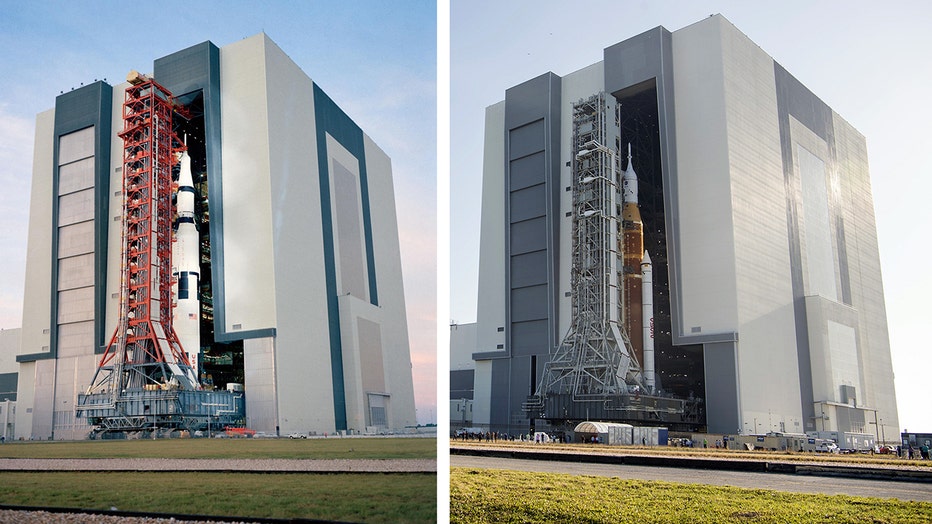
On the left, the Saturn V rocket for the Apollo 14 mission rolls out to the pad in 1970. On the right, the crawler-transporter is seen carrying the Artemis I rocket in 2022. (NASA / Aubrey Gemignani)
Most powerful rocket – eventually
In sheer scale, the SLS rocket nearly lives up to the Saturn V legacy. This "Block 1" initial SLS version clocks in at 322 feet high – taller than the Statue of Liberty but not as tall as the 363-foot Saturn V. Later versions of the SLS could cap out at 365 feet, though, eclipsing the famed moon rocket.
Where the SLS does top the Saturn V is launch thrust. With the help of two upgraded solid rocket boosters, the SLS will be 15% more powerful than the Saturn V, generating 8.8 million pounds of thrust at launch.
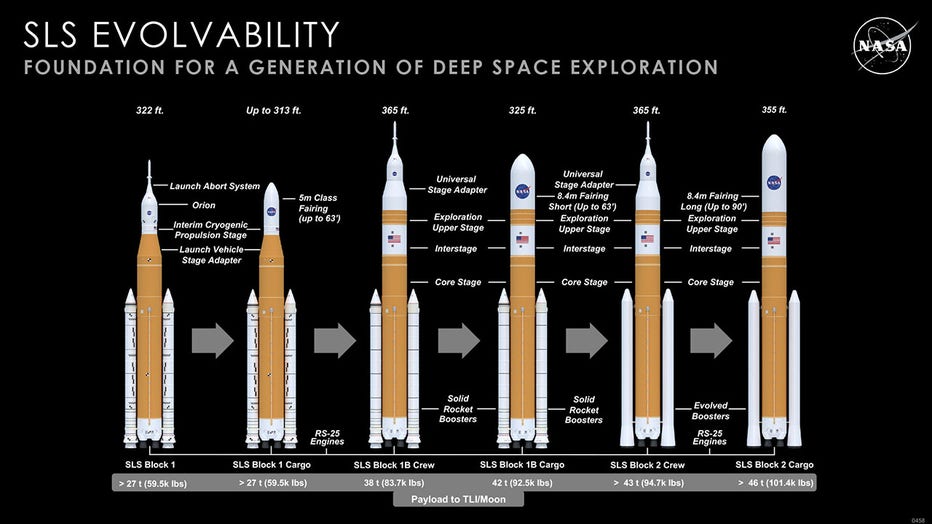
An artist rendering shows how engineers are designing NASA’s new rocket, the Space Launch System (SLS) to evolve to various configurations capability of supporting different types of crew and cargo missions. (NASA / MSFC image)
That will make it the most powerful rocket ever to successfully fly. The Soviets’ secret moon rocket, the N1, was equipped with 30 first-stage rocket engines capable of over 10-million pounds of thrust, but all four test launches failed; the longest flight did not last two minutes.
Space shuttle legacy
SLS is based on a lot of space shuttle elements, and at first glance, it’s easy to spot some of the similarities: the bright orange fuel tank, the pencil-shaped solid rocket boosters. But the engines themselves are not just similar to shuttle engines – they are space shuttle engines.
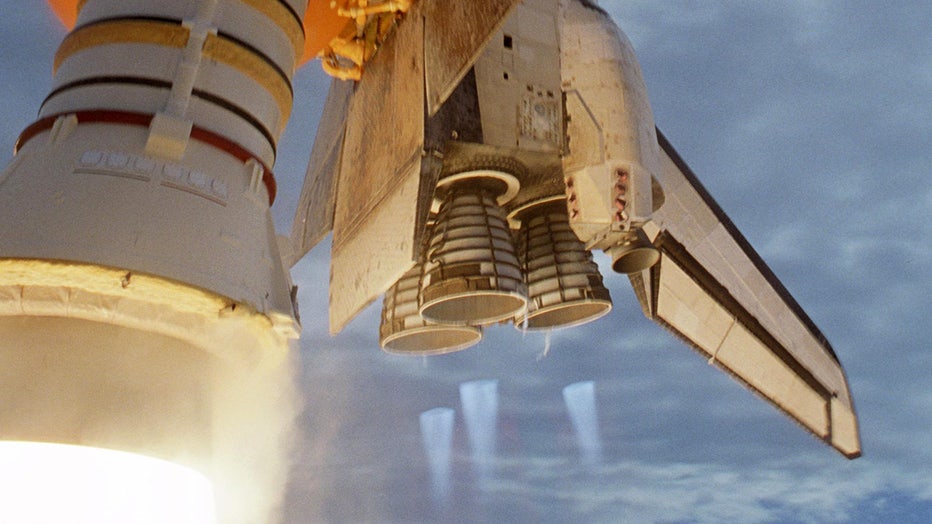
Space shuttle Discovery roars into the blue Florida sky on mission STS-120 in 2007. (NASA photo / Tom Farrar, Scott Haun, Raphael Hernandez)
Each space shuttle was equipped with three RS-25 main engines, guzzling liquid oxygen and hydrogen from the orange external tank as they powered the reusable orbiter to space. Those engines were swapped out and refurbished after landing.
Over three decades of the shuttle program, 46 engines were produced. Of those, NASA saved 16 for use as the main engines on what became the SLS rockets; 24 more will be manufactured for future flights.

All four RS-25 engines were structurally mated to the core stage for NASA’s Space Launch System (SLS) rocket in 2019. (NASA photo / Eric Bordelon)
For the Artemis I mission, four veteran engines were selected, with a combined 25 flights between them, according to NASA:
- Engine E2045: The most veteran engine with 12 flights, including a docking with Mir in 1998 and John Glenn's flight, also in 1998
- Engine E2056: Four flights, including STS-109, a Hubble Telescope servicing trip and Columbia’s last successful mission
- Engine E2058: Six flights, all to build the space station
- Engine E2060: Three flights, most notably STS-135 Atlantis, the final shuttle mission
Unlike the shuttle program, though, the SLS rocket’s core stage won’t be reused. The stage and its engines will instead be dropped in the Atlantic when its fuel is gone – Apollo-style – which means these four old shuttle engines won’t ever fly again after the Artemis I mission.
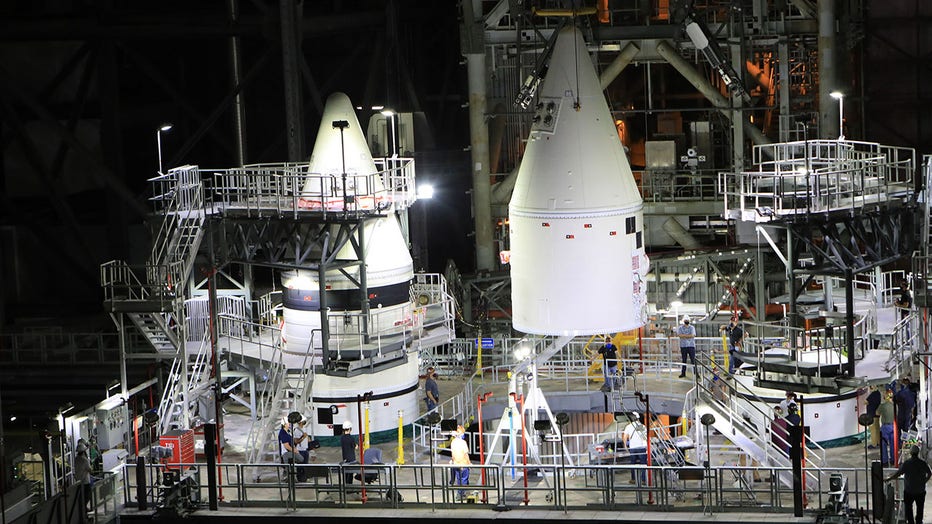
Technicians place the forward nose assemblies on top of the SLS SRBs in March of 2021. The reusable segments date back to the 1980s. (NASA photo)
But not all of the legacy elements will be lost in a final blaze of glory. Many segments of the reusable solid rocket boosters were also migrated to SLS from the space shuttle program, and some of the Artemis I booster segments date back to the mid-1980s.
In fact, NASA data shows both of the white nose cone segments atop the Artemis I boosters flew on over 10 shuttle missions as far back as STS-41G, a 1984 flight of space shuttle Challenger.
Artemis I mission
The SLS will power the Artemis I test flight later this year. That will feature an uncrewed flight around the moon by the Orion capsule, which made its debut in a successful 2014 test flight atop a Delta IV Heavy rocket.
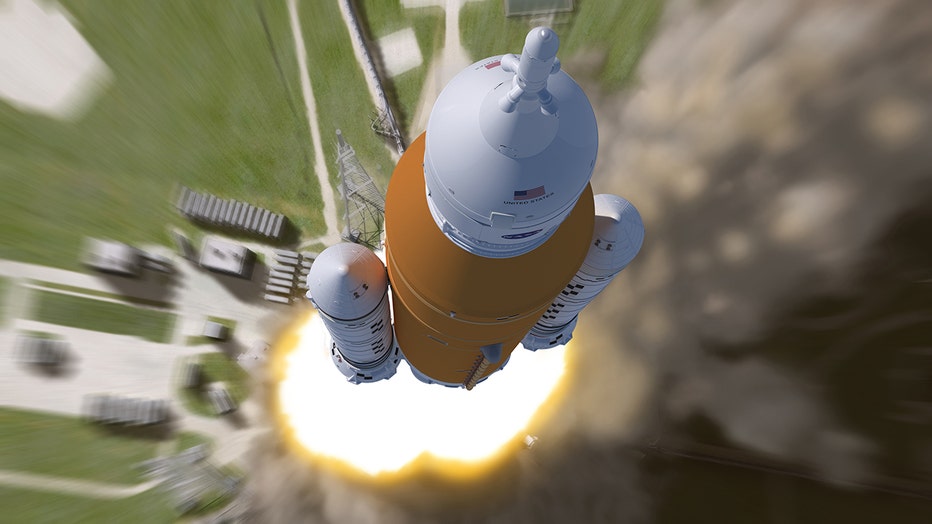
An artist's rendering shows an aerial view of the liftoff of NASA’s SLS rocket. (NASA / MSFC photo)
Artemis I is designed to test not only the rocket, but the capsule’s ability to launch into space, enter into lunar orbit, and splash down safely after re-entering the atmosphere at nearly 25,000 mph.
The 25-day mission is set to blast off this summer.
RELATED: NASA will fly your name to the Moon and back on Artemis I mission
What’s next?
Before launch, the Artemis I SLS rocket and its support tower will undergo ground tests at Launch Pad 39B. The most significant test will be what NASA calls a "wet dress rehearsal," which is a simulated countdown that includes filling the rocket with 700,000 gallons of its supercold fuel for the first time.
The WDR is currently scheduled to begin as early as April 1.
Assuming the Artemis I mission flies successfully this summer, the Artemis II mission – a similar flight plan, but with four people aboard – could happen within two years.
The goal of the Artemis program is to return humans to the moon, including the first woman and first person of color. Artemis III, the first moon landing mission, will be no earlier than 2025.
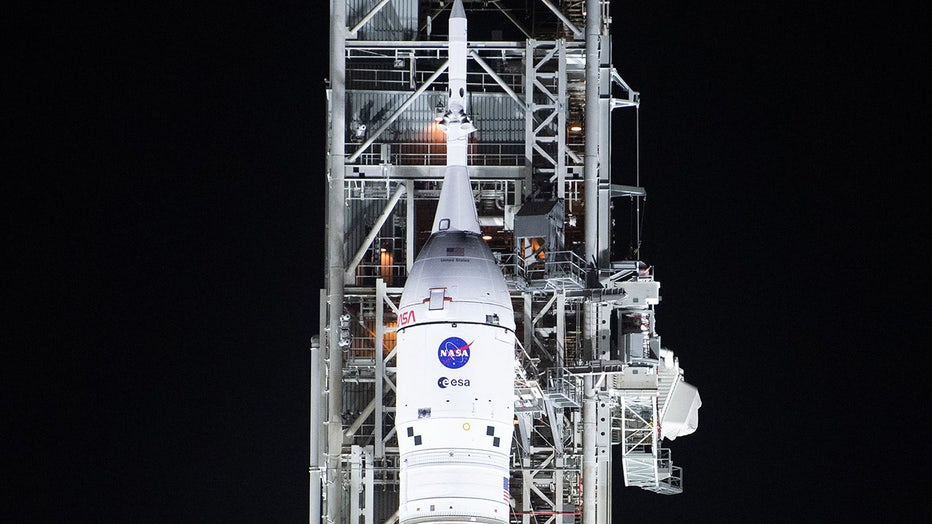
The Orion spacecraft is seen illuminated by spotlights atop its SLS rocket at Launch Complex 39B, Friday, March 18, 2022. (NASA / Joel Kowsky)
RELATED: NASA wants your ideas for next-generation 'Astrovan'

